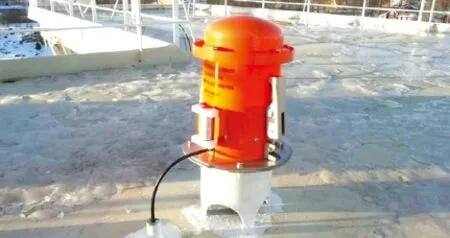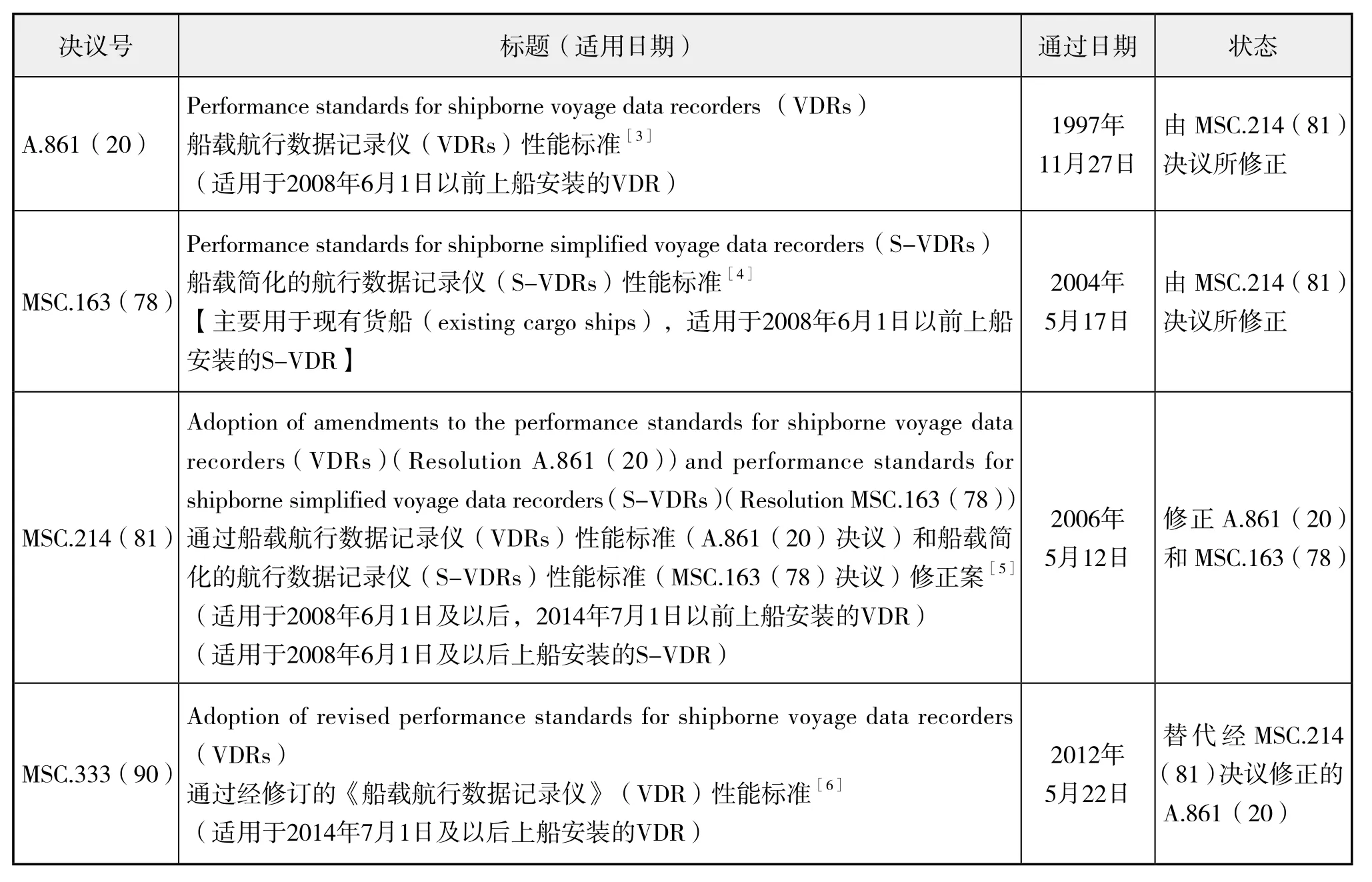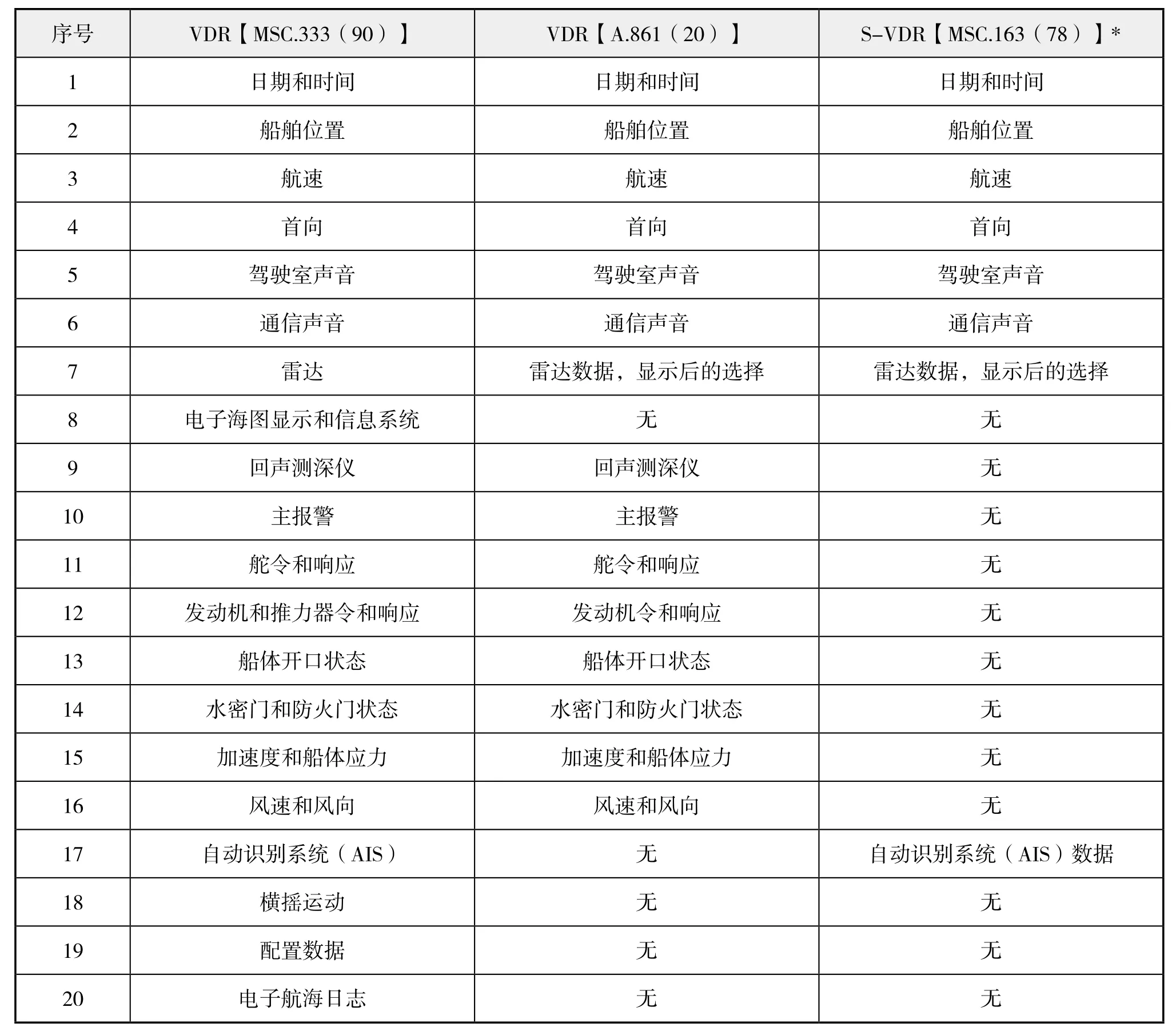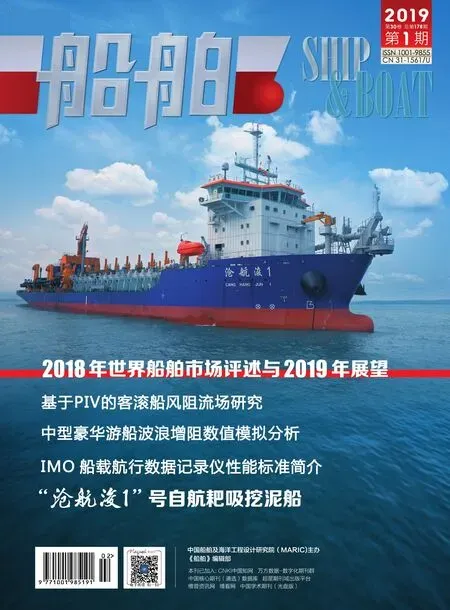IMO船载航行数据记录仪性能标准简介
林德辉
(中国船舶及海洋工程设计研究院 上海200011)
1 飞行数据记录仪与航行数据记录仪
大多数飞机上安装的黑匣子有两种。一种是称为“飞行数据记录仪”(Flight Data Recorder,FDR)的黑匣子[1],专门记录飞行中的各种数据(包括飞行姿态、飞行轨迹、飞行速度、加速度、经纬度、航向以及作用在飞机上的各种外力等,可累计记录25 h),一旦出现空难,整个事故过程中的飞行参数就能从黑匣子中找到,人们便可知道飞机失事的原因。另一种是称为“驾驶舱话音记录器”(Cockpit Voice Recorder,CVR)的黑匣子,就像录音机一样,它通过安放在驾驶舱及座舱内的扬声器,录下飞行员与飞行员之间,以及座舱内乘客、劫机者与空中小姐的讲话声,它记录的时间为30 min,超过30 min又会重新开始录音。因此这个黑匣子内录存的是空难前30 min机内的重要信息(上世纪90年代后出现了集成电路存贮器,像电脑中的内存条那样,可记录2 h的CVR声音)。
飞行数据记录仪之所以被称为“黑匣子”可追溯到1954年,当时飞机内所有的电子仪器都放置在大小、形状均统一的黑色方盒里。但现在的飞行数据记录仪已不是黑色,为了便于寻找,“黑匣子”已全部采用了国际通用的桔红色,且涂有反射条带,还装备了水下定位信标(Underwater Locator Beacon,ULB)。当飞机坠入水中时,信标开始发送超声波脉冲,这种脉冲可以被声纳和声学定位仪探测到。在信标的一端有像公牛眼一样的水下传感器。当水接触到传感器,信标就会被激活而发出超声波脉冲。信标通常发送37.5 kHz的脉冲信号,且能从深为4 267 m(14 000 ft)的水下传递声音。一旦信标开始工作,它会每秒发送一次信号,且持续30 d。在十分罕见的情况下,信标才可能被强大的力量冲击而折断。
为了承受飞机坠毁时的猛烈撞击和高温烈焰,黑匣子的外壳具有很厚的钢板和许多层绝热防冲击保护材料。且为了尽可能地安全,黑匣子通常安装在飞机尾部最安全的部位,也就是失事时最不易损坏的部位,在飞机坠毁时,黑匣子在1 100 ℃的火焰中能经受30 min的烧烤,能承受2 000 kg物体挤压5 min,能在汽油、机油、电池酸液、海水中浸泡几个月,总之,它能在许多恶劣条件下安然无恙。
船载“航行数据记录仪”(Voyage Data Recorder,VDR)俗称船舶“黑匣子”,是专门用于记录船舶航行数据的仪器,当船舶发生事故时,该数据在分析事故时起到不可替代的重要作用。
与飞行事故相比,由于船舶事故一般从开始到结束时间比较长,调查起来相对较容易。所以对“航行数据记录仪”的需求不如“飞行数据记录仪”那样迫切,因此在记录技术较落后的20世纪60年代(飞机黑匣子问世)也就没有船用黑匣子的需求,一直到记录技术较成熟的20世纪90年代才有这样的需求和产品。
船舶黑匣子的主机一般安置于驾驶室,其记录介质中保存着有关数据。在一般情况下,可通过外部设备提取相关数据,供分析事故使用;另有一个副机与主机相连接,称为航行数据记录仪,又称数据同步记录介质(复制件),外型与卫星示位标大小相仿,外观为桔红色,安装在上层甲板,如图1所示[2]。当船舶发生重大沉船事故而船员又没能带走黑匣子的主机时,副机会因浸水改变压力而自行弹离船体,上浮到海面,以便于被寻找。黑匣子采用了与飞机黑匣子类似的抗压力、抗海水腐蚀、抗高温等特殊材料来确保有关数据在恶劣环境下不会丢失。
VDR在每间隔一单位时间(可根据需要事先设定记录间隔,如每分钟一次)和每发生一个事件(如动车钟)时,就自动记录一组数据。

图1 安装在上层甲板的船载“航行数据记录仪”
随着通信技术的发展,对于像飞机或船舶黑匣子记录容量的记录进行实时传输已不是问题。国际民航组织(International Civil Aviation Organization,ICAO)已着手研制实时传输系统来取代目前的黑匣子系统,目前的黑匣子仅作为实时传输系统的备份,所有需要进入黑匣子的数据全部经实时传输系统传输到飞行控制中心,控制中心能随时取得第一手的有用资料,当发动机发生故障时,控制中心还能提醒并指导飞机驾驶人员采取正确处理方法。
实时传输系统对船舶来说更为诱人,由于船舶对事件的处理时间较宽裕,航行控制中心通过实时传输系统能直接获取所有航行相关信息,航行控制中心就有充足时间组织专家对船舶或机械设备的维修等进行指导,对避碰方案提出具体意见。可以预见,VDR、实时传输系统和航行控制中心相结合,将使未来船舶航行更安全。
2 国际海事组织对VDR性能标准的决议
国际海事组织(IMO)在2012年5月22日召开的第90届海上安全委员会(MSC 90)会议上通过了《经修订的船载航行数据记录仪(VDR)性能标准》(MSC.333(90)决议),其适用于2014年7月1日及以后上船安装的VDR。这是继经MSC.214 (81) 决议修正的A.861 (20) 决议《船载航行数据记录仪(VDR)性能标准》和MSC.163 (78) 决议《船载简化的航行数据记录仪(S-VDR)性能标准》之后,对VDR性能标准的再次修订。IMO对VDR和S-VDR性能标准的4项决议,以及它们的适用日期和通过日期等,详见表1。

表1 IMO对VDR和S-VDR性能标准的4项决议
3 VDR性能标准的目的和10项定义
MSC.333 (90) 《经修订的船载航行数据记录仪(VDR)性能标准》对原《船载航行数据记录仪 (VDRs)性能标准》作了较大修订。MSC.333 (90) 的附件“经修订的船载航行数据记录仪(VDR)性能标准的建议”分为9个部分:
—— 1目的(PURPOSE);
—— 2适用范围(APPLICATION);
—— 3参考资料(REFERENCES);
—— 4定义(DEFINITIONS);
—— 5运行要求(OPERATIONAL REQUIREMENTS);
—— 6运行(OPERATION);
—— 7文件(DOCUMENTATION);
—— 8接口连接(INTERFACING);
—— 9 调查机构所使用的下载和回放设备(DOWNLOAD AND PLAYBACK EQUIPMENT FOR INVESTIGATION AUTHORITIES)。
在“1 目的”中,明确:
船载航行数据记录仪(VDR)旨在以一种可靠和可恢复的方式(in a secure and retrievable form),保持船舶在发生有影响的事故前后一段时间(over the period leading up to and following an incident having an impact thereon),与船舶位置、运动状态、实际状况、指挥和控制相关信息(information concerning the position, movement, physical status, command and control of a ship)的储存。主管机关和船东均应可获取VDR内的信息(Information contained in a VDR should be made available to both the Administration and the shipowner)。这些信息用于随后的安全调查,以识别事故原因(This information is for use during any subsequent safety investigation to identify the cause(s) of the incident)。
在“4 定义”中,除对原标准的5项定义作修改外,新增了5项定义,使定义增至10项:
—— 4.1 航行数据记录仪(Voyage Data Recorder,VDR)系指一个完整的系统,包括与输入信号源相连所需的任何项目(including any items required to interface with the sources of input signals)、数据处理和编码装置(processing and encoding)、最终记录介质、回放设备、电源和专用的备用电源。
—— 4.2 信号源(Signal source)系指VDR所连的任何外部传感器或装置(any sensor or device external to the VDR),VDR从其获得将被记录的信号和数据(from which it obtains signals and data to be recorded)。
—— 4.3 最终记录介质(Final recording medium)系指记录数据的硬件装置(the items of hardware on which the data is recorded),通过采用适当的设备,访问其中任何一个,便能获取到数据且回放。固定记录介质、自浮记录介质和长期记录介质组合在一起,即为最终记录介质。
—— 4.4 固定记录介质(Fixed recording medium)系指最终记录介质的一部分,其具有保护,以防止在失火、冲击、渗透和海底长期浸泡后损坏(protected against fire, shock, penetration and a prolonged period on the ocean floor)。它可从沉船的甲板处回收(It is expected to be recovered from the deck of the ship that has sunk),且有指示其位置的设施。
—— 4.5 自浮记录介质(Float-free recording medium)系指最终记录介质的一部分,其应在船舶沉没后自浮于水面(which should float-free after a sinking),且有指示其位置的设施。
—— 4.6 长期记录介质(Long-term recording medium)系指最终记录介质中永久安装的部分(a permanently installed part of the Final Recording Medium)。它具有最长的持续记录期,且具有易于读取的接口,用于下载其存储的数据(It provides the longest record duration and has a readily accessible interface for downloading the stored data)。
—— 4.7 回放设备(Playback equipment)系指任何数据介质,其附带回放软件、运行说明书(any data medium with the playback software, the operational instructions),以及为将商用现成的笔记本电脑连接至VDR所要求的任何专用部件(any special parts required for connecting a commercial off-the-shelf laptop computer to the VDR)。
—— 4.8 回放软件(Playback software)系指一份软件程序,其具有下载存储数据且回放其信息的能力(a copy of the software program to provide the capability to download the stored data and play back the information)。该软件应与商用现成的笔记本电脑所可用的操作系统相兼容(The software should be compatible with an operating system available with commercial off-the-shelf laptop computers),且对于在VDR中采用的非标准或专有格式(non-standard or proprietary formats)存储的数据,该软件应能将其转换为公开的行业标准格式(open industry standard formats)。
—— 4.9 专用的备用电源(Dedicated reserve power source)系指专用于VDR的带有合适的自动充电装置(with suitable automatic charging arrangements)的蓄电池,其须具有符合5.4.2要求的足够容量【应使VDR在2 h内连续记录驾驶室声音(continue to record Bridge Audio)】。
—— 4.10 配置数据(Configuration data)描述了船舶的设备,其在船上的安装以及与VDR的关系(describes the vessel's equipment, its installation on the vessel and its relation to the VDR)。存储和回放软件使用该数据来存储数据记录(The storage and playback software uses this data to store the data record),且在回放时将这些数据记录转换为有助于事故调查的信息(to convert the data record into information that assists casualty investigation during playback)。
4 VDR的运行要求
在“5 运行要求”中,除作修改外,还新增了一些条款。其中在“5.1通则”中涉及:
—— 5.1.1 VDR应连续地保持按顺序记录与船舶设备的状况和输出相关的预先选定的数据项(The VDR should continuously maintain sequential records of preselected data items relating to the status and output of the ship's equipment),以及船舶的命令和控制,参见5.5。
—— 5.1.2为允许事后对事故的各因素进行分析,记录的方法应确保在适当设备上回放时,各数据项能在日期和时间上相互关联(the method of recording should ensure that the various data items can be co-related in date and time during playback on suitable equipment)。
—— 5.1.3该系统应包括能在任何时候(例如每年,或对VDR或向VDR提供数据的任何信号源进行修理或维护后)进行性能试验的功能。这种试验可使用回放设备进行,且应确保所有要求的数据项均被正确记录(This test may be conducted using the playback equipment and should ensure that all the required data items are being correctly recorded)。
—— 5.1.4按A.694 (17) 决议“作为全球海上遇险与安全系统 (GMDSS) 之组成部分的船载无线电设备和电子航行设备的一般要求”【General requirements for shipborne radio equipment forming part of the global maritime distress and safety system (GMDSS) and for electronic navigational aids】和IMO接受的国际标准IEC 60945“海上导航和无线电通信设备及系统—一般要求—试验方法及所要求的试验结果”所进行的设计和建造,应特别考虑到5.3和5.4中详述的数据安全性和运行连续性的要求(the requirements for data security and continuity of operation)。
在“5.2最终记录介质”中,新增“5.2.1 固定记录介质”,其内容为:
固定记录介质应安装在固定的保护容器(fixed protective capsule)中,且满足下列所有要求:
—— 5.2.1.1 在事故之后应能访问,且应确保防止记录的数据遭到物理性或电子操作性的改变或删除(against a physical or electronically manipulated change or deletion of recorded data);
—— 5.2.1.2 在记录终止后应保持记录的数据至少2年;
—— 5.2.1.3 应使在失火、冲击、贯穿和深水压力之下的生存概率最大化(maximize the probability of survival against fire, shock, penetration and deep-sea-pressure),且在任何事故之后恢复最后记录数据(recovery of the final recorded data after any incident);
—— 5.2.1.4 应具有高度显见的颜色(highly visible colour),且以反光材料进行标识(marked with retroreflective materials);和
—— 5.2.1.5 应配以合适的装置,以有助于水下定位(to aid location under water)。
新增“5.2.2自浮记录介质”,其内容为:
自浮记录介质应安装在自浮的容器中,且满足下列所有要求:
—— 5.2.2.1 应配有易于钩取和回收的设施(be fitted with means to facilitate grappling and recovery);
—— 5.2.2.2 在记录终止后应保持记录的数据至少6个月(maintain the recorded data for a period of at least six months following termination of recording);
—— 5.2.2.3 其构造应满足A.810 (19) 决议“在406 MHz上工作的自浮式卫星应急无线电示位标(EPIRBs)的性能标准”的要求,且在回收作业中使损坏风险降至最低(to minimize risk of damage during recovery operations);
—— 5.2.2.4 应能发送初始定位信号,且在随后不少于7d / 168h的时间内至少发送48 h的定位导引信号(be capable of transmitting an initial locating signal and further locating homing signal for at least 48 hours over a period of not less than seven days/168 hour);和
—— 5.2.2.5在事故之后应能访问(be capable of being accessed following an incident),但应保护记录的数据,使其免受物理性或电子操作性的改变或删除(but secure against a physical or electronically manipulated change or deletion of recorded data)。
新增“5.2.3长期记录介质”,明确了,长期记录介质:
—— 5.2.3.1应能从船舶内部易于到达的区域访问(be capable of being accessed from an internal, easily accessible area of the ship);且
—— 5.2.3.2提供对其上保存数据的访问口(provide access to the data held on it),但应保护记录的数据,使其免受物理性或电子操作性的改变或删除。
在“5 运行要求”中还包括“5.3数据选择和安全性”(Data selection and security)、“5.4运行连续性”(Continuity of operation)和“5.5应记录的数据项”(Data items to be recorded)。
在“5.3数据选择和安全性”中阐明:
—— 5.3.1在5.5中规定了应由VDR记录的最少的数据项, 只要不影响指定选择数据项的记录和储存的要求,视情况可记录附加的项目。
—— 5.3.2 设备应尽实际可能地(as far as is practical)设计成,不能对VDR所记录的数据量、数据本身或者已记录的数据进行操纵修改(it is not possible to manipulate the amount of data being recorded by the VDR, the data itself nor the data which has already been recorded)。任何干扰数据或记录完整性的企图均应予以记录(Any attempt to interfere with the integrity of the data or the recording should be recorded)。
—— 5.3.3 记录的方法应能对每项记录数据进行完整性检查,且如发现无法纠正的错误(if a noncorrectable error is detected),应发出报警。
在“5.4运行连续性”中阐明:
—— 5.4.1 VDR应可由船舶的主电源和应急电源供电。
—— 5.4.2 如船舶主电源发生故障,则VDR应通过专用的备用电源(dedicated reserve power source)在2 h内连续记录驾驶室声音(见5.5.5)。在2 h结束时,所有记录应自动停止(At the end of this 2 hour period all recording should cease automatically.)。
—— 5.4.3除非按5.4.2的要求被停止,记录应连续。对长期记录介质,所有存储数据项保留的时间应至少为30 d/720 h,而对固定记录介质和自浮记录介质,所有存储数据项保留的时间应至少为48 h(The time for which all stored data items are retained should be at least 30 days/720 hours on the long-term recording medium and at least 48 hours on the fixed and float-free recording media)。超过了此规定保留时间的数据项,可以被新数据所覆盖(Data items which are older than this may be overwritten with new data)。
5 VDR应记录的数据项
MSC.333 (90) “5.5应记录的数据项”是该标准中内容最详尽的章条,共列出了20项。
—— 5.5.1日期和时间(Date and time) 参照UTC(Universal Time Co-ordinated,世界协调时)的日期和时间应取自船舶外部来源(should be obtained from a source external to the ship),且内部时钟应与有效的日期和时间数据同步(an internal clock should be synchronized with valid date and time data)。在外部数据源丢失期间,应使用内部时钟(During times of a loss of the external source, the internal clock should be used)。记录的方法应使得在回放时可获得所有其他记录的数据项的定时(The recording method should be such that the timing of all other recorded data items can be derived on playback),其分辨率和连续性应足以详细地重现事故的经历(with a resolution and continuity sufficient to reconstruct the history of the incident in detail)。
—— 5.5.2船舶位置(Ship's position) 经纬度和所使用的数据(Latitude and longitude, and the datum used)应从电子定位系统(electronic position-fixing system,EPFS)中获得。记录应确保EPFS的同一性和状况(the identity and status)可始终在回放中得到确认。
—— 5.5.3航速(Speed)对水航速和对地航速,包括是哪一种航速的指示(Speed through the water and speed over the ground, including an indication of which it is),可从“国际海上人命安全公约”(SOLAS)条款所要求的船舶航速和航程测量设备(ship's speed and distance measuring equipment)中获得。
—— 5.5.4首向(Heading) 从船舶首向源(ship's heading source)获得首向指示。
—— 5.5.5驾驶室声音(Bridge audio) 应在驾驶室设置如MSC/Circ.982通函所述的覆盖所有工作站的扩音器(Microphones should be positioned on the bridge covering all work stations as described in MSC/Circ.982),以便记录对话。当船舶正常运行时,记录应使得在回放时,应提供足以可理解的正常说话声音(The recording should be such that, on playback, a normal speaking voice should provide adequate intelligibility)。当在驾驶室任何地方有单个声报警或任何噪声,包括来自故障设备或基座的噪声或风声时,应在所有工作站保持此记录回放性能(This performance should be maintained at all work stations while there is a single audio alarm anywhere on the bridge or any noise, including noise from faulty equipment or mounting, or wind)。 这 应通过至少使用两个声道记录声音来达到(This should be achieved through the use of at least two channels of audio recording)。位于驾驶桥楼翼台外的扩音器应至少在一个附加的单独声道上进行记录(Microphones positioned outside on bridge wings, should be recorded on at least one additional separate channel)。
—— 5.5.6通信声音(Communications audio) 与船舶运行相关的甚高频(VHF)通信应记录在5.5.5中所述的附加的单独声道中。
—— 5.5.7雷达(Radar) SOLAS条款所要求的两台船上雷达装置的主显示器上的电子信号(The electronic signals of the main displays of both ship's radar installations)。尽管已使用对VDR工作非常重要的有限宽带压缩技术(albeit within the limitations of any bandwidth compression techniques that are essential to the working of the VDR),记录方式应能在回放时如实再现记录当时所看到的完整的雷达显示(The recording method should be such that, on playback, it is possible to present a faithful replica of the entire radar display that was on view at the time of recording)。
—— 5.5.8电子海图显示和信息系统(ECDIS) 如船舶安装了ECDIS,VDR应记录作为主要航行设施(primary means of navigation)使用的ECDIS显示器的电子信号(electronic signals of the ECDIS display)。尽管已使用对VDR工作非常重要的有限宽带压缩技术,记录方式应能在回放时如实再现记录当时所看到的完整的ECDIS显示(entire ECDIS display),且还应显示海图数据和使用版本的来源(in addition the source of the chart data and the version used)。
—— 5.5.9回声测深仪(Echo sounder) 水深资料。应包括龙骨下水深(depth under keel)、当前显示的测量水深(the depth scale currently being displayed)和其他状态资料(如可获得)。
—— 5.5.10主报警(Main alarms) 应包括驾驶室内所有强制性报警(all mandatory alarms on the bridge,见A.1021(26)决议“2009年报警器和指示器规则”)的状态,或从驾驶室报警管理系统(Bridge Alert Management System,如安装)收到的强制性报警的状态,应作为单个已识别的报警(individually identified alarms)予以记录。
—— 5.5.11舵令和响应(Rudder order and response) 应包括首向或航迹控制器(heading or track controller)的状态和设定(如设置),且须显示控制站、模式和所使用的电源(and indicate the control station, mode, and power units in use)。
—— 5.5.12发动机和推力器令和响应(Engine and thruster order and response) 应包括在驾驶室所显示的任何发动机车钟的位置(positions of any engine telegraph)或发动机/推进器直接控制指令(direct engine/propeller controls)和反馈指示(如安装),包括前进/后退指示和指示哪个控制站正在使用(including ahead/astern indicators and indicate the control station in use)。还应包括任何推力器(如安装),且显示其正在使用的控制站(indicate the control station in use)。
—— 5.5.13船体开口状态(Hull openings status) 应包括要求在驾驶室予以显示的所有强制性状态信息(all mandatory status information)。
—— 5.5.14水密门和防火门状态(Watertight and fire door status) 应包括要求在驾驶室予以显示的所有强制性状态信息。
—— 5.5.15加速度和船体应力(Accelerations and hull stresses) 如船舶安装了船体应力和响应的监测设备(hull stress and response monitoring equipment),则应记录该设备中已预选的所有数据项(all the data items that have been pre-selected within that equipment should be recorded)。
—— 5.5.16风速和风向(Wind speed and direction) 如船舶安装了合适的传感器(a suitable sensor),则应记录风速和风向,包括其实际状态和相对状态(wind speed and direction should be recorded, including its true or relative status)。
—— 5.5.17自动识别系统(AIS) 应记录所有AIS(Automatic Identification System)数据。
—— 5.5.18横摇运动(Rolling motion) VDR应与电子倾斜仪(electronic inclinometer,如安装)相连接。记录方式应能在回放时再现横摇运动(The recording method should be such that the rolling motion can be reconstructed during playback)。
—— 5.5.19配置数据(Configuration data) 在VDR调试期间(during commissioning of the VDR),除了5.5.1至5.5.18所规定的数据项外,还应在最终记录介质中写入规定VDR配置以及与其相连接传感器的数据块(a data block defining the configuration of the VDR and the sensors to which it is connected should be written into the final recording medium)。该数据块应在安装上船时保持更新(The data block should be maintained up to date with respect to the vessel installation)。其应包括传感器制造商详情、型号和版本号、传感器的标识和位置,以及传感器数据的解释。此配置数据应永久地保存在最终记录介质中(This configuration data should be permanently retained in the final recording media),且除了在配置发生任何改变后由正式授权人员修改外,其应具有防止被其他人员修改的保护(and protected from modification other than by a duly authorized person following any change to the configuration)。
—— 5.5.20电子航海日志(Electronic logbook) 如船舶按IMO的标准装设电子航海日志,则应记录该日志上的信息。
以上为MSC.333(90)《经修订的船载VDR性能标准》“5.5应记录的数据项”中要求的20个数据项。
在A.861(20)《船载VDRs)性能标准》“5.4应记录的数据项”中要求的数据项为15项,以上5.5.8以及5.5.17至5.5.20共5项为MSC.333(90)中新增的。
而MSC.163(78)《船载S-VDR性能标准》中明确要求的数据项仅为8项,此外,尚有其他数据项,见表2的注(*)。
这些IMO决议对于VDR和S-VDR应记录的数据项[3-4,6],详见下页表2。
6 VDR的运行、文件和接口连接
在“6 运行”中明确,装置在正常运行中应完全自动化。
在“7 文件”中阐明,应至少以英文提供描述长期记录介质接口之位置的信息(Information describing the location of the long-term recording medium interface)以及描述与9中所述者接口之方法的说明(instructions describing the means of interfacing with it as referred to in 9)。设备的文件应包括,这些信息和说明的位置应尽实际可行地靠近长期记录介质接口的显著部位处的指南(guidance for the placement of the information and instructions at a prominent position as close to the long-term recording medium interface as practicable)。
在“8 接口连接”中要求,与所要求各信号源的接口连接应尽可能符合相关国际接口标准(Interfacing to the various signal sources required should be in accordance with the relevant international interface standard,
where possible),即IEC 61162《海上导航和无线电通信设备及系统—数字接口》(Maritime navigation and radiocommunication equipment and systems — Digital interfaces)的要求。即使此VDR系统发生故障(even if the VDR system develops faults),其与船舶设备的任何部件的任何连接都不应使该设备的运行变得失效(Any connection to any item of the ship's equipment should be such that the operation of that equipment suffers no deterioration)。

表2 VDR和S-VDR应记录的数据项
“9 调查机构所使用的下载和回放设备”的绝大部分内容是MSC.214(81) 对A.861(20)和MSC.163(78))的修正中新增的,MSC.333 (90)基本上保持了MSC.214(81)中新增的“8 调查机构所使用的下载和回放设备”的内容,只是由于新增了“7 文件”,因此此标题的编号由8改为9。“9 调查机构所使用的下载和回放设备”包括“9.1数据输出接口”(Data output interface)和“9.2数据下载和回放的软件”(Software for data downloading and play back)。与MSC.214(81)的内容相比较,MSC.333 (90) 仅在9.1的最后增加一句:“其应能在用户规定的时间段内下载所记录的数据”(It should be possible to perform a download of the recorded data for a user-defined period of time.)。
7 结 语
以上为MSC.333 (90) 对原VDR性能标准所作的部分修订及其主要内容,整个修订涉及内容广泛,考虑到IMO建议各国政府确保在2014年7月1日及以后安装的VDR符合不低于MSC.333 (90) 所规定的性能标准,值得引起船舶设计者关注。

